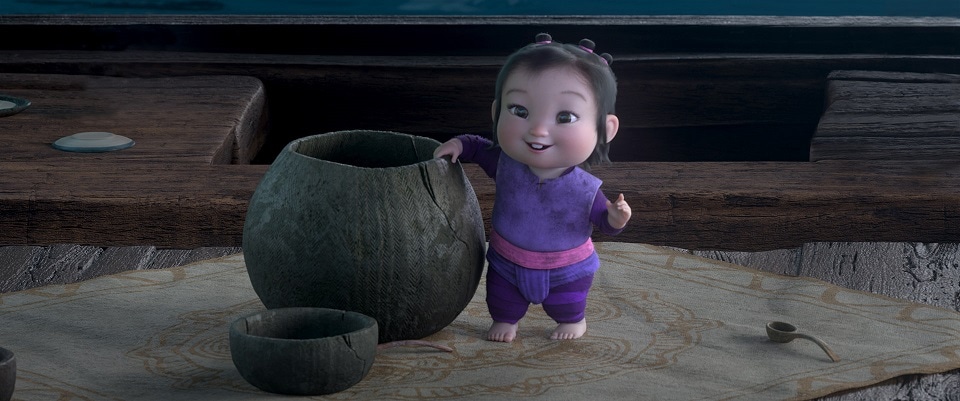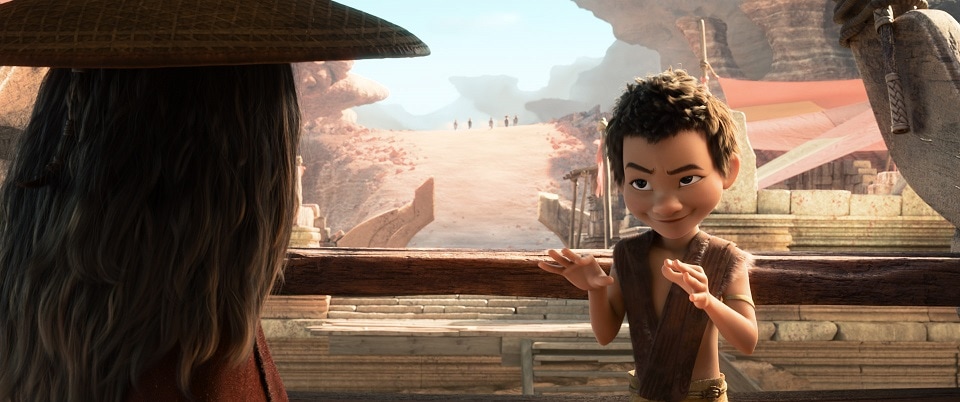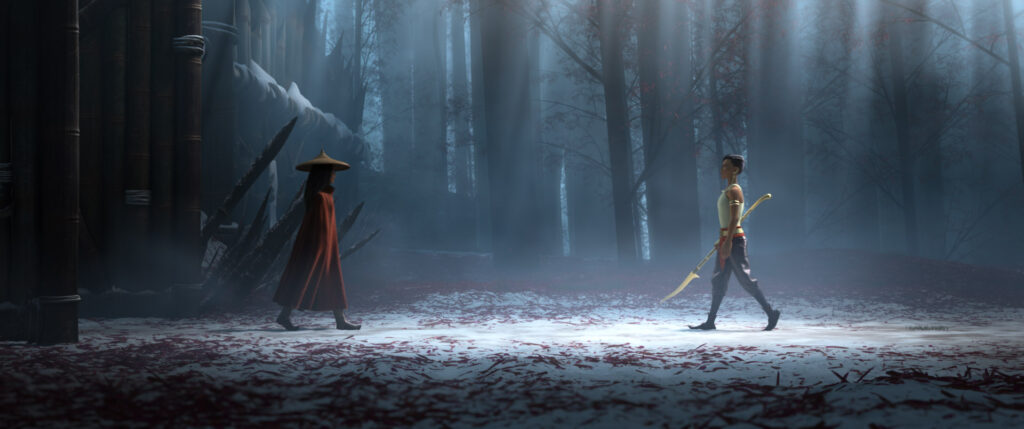RAYA AND THE LAST DRAGON arrives on 4K Ultra HD, Blu-ray, and DVD May 18 with never-before-seen bonus footage and deleted scenes, plus Disney’s new animated short, Us Again.

This post contains affiliate links.

Director Carlos López Estrada, Producer Osnat Shurer, and Head of Story Fawn Veerasunthorn

Director Don Hall, Writer Adele Lim, & Writer Qui Nguyen
Meet the Talent Behind RAYA AND THE LAST DRAGON
To celebrate the home release of RAYA AND THE LAST DRAGON, we sat down via Zoom and interviewed the talent behind the movie. Director Carlos López Estrada, Producer Osnat Shurer, and Head of Story Fawn Veerasunthorn, as well as Director Don Hall, Writer Adele Lim, & Writer Qui Nguyen.
This was actually my second time getting to speak with Fawn. Last time she showed a group of us how to draw Tuk Tuk!

© 2021 Disney. All Rights Reserved.
Creating a film during a pandemic
In addition to one of the Bonus Features about working from home during the pandemic (“Raya: Bring it Home”), we’ve learned some fascinating details from the talent we’ve interviewed over the past few months about filmmaking in general—and animated films specifically—during the pandemic. Walt Disney Animation Studios has over 900 people in its creative community.
At one point, Director Carlos López Estrada told us they had over 400 people working from home on the film. They were of course worried about how it would affect the film and their work culture but at the end of the day, “it brought us together and brought us together in a way that was powerful. And that was really profound, and that it forced us to have to trust each other to have to believe that we were all working for the same goal, even if we were in over 400 different locations.”

RAYA AND THE LAST DRAGON – Sisu. © 2021 Disney. All Rights Reserved.
Writer Qui Nguyen said when it first started, it was kind of a scary notion that they were going to make a movie remotely. One of the superpowers that Disney has is it’s carried these amazing artists for years and years. “The special ingredient has always been the way we collaborate with each other, live in person, in a room,” Nguyen said. It was terrifying to change up how they had been doing things for years to make this one film, but what they discovered—much like the theme of the movie—is that they kind of trust in each even other more and trust that their colleagues to do work without someone working at their side.
“I think everyone kind of stepped up the challenge in some amazing, beautiful ways,” Nguyen said. “Don’s been here for a long, long, long time, and he constantly says how beautiful the film is, one of the most beautiful he’s seen, and he’s seen it all. I think it’s a testament to not just the hard work he’s done, but the hard work that everyone in our studio has done. And it’s been beautiful to see how both the theme of trust and just the action of trusting each other as collaborators have really made this incredible experience and incredible movie.”

© 2021 Disney. All Rights Reserved.
Creating a short story versus a feature film
Many of the talent behind RAYA AND THE LAST DRAGON has worked on numerous other films, animated & live-action, short films & full-length features. Producer Osnat Shurer specifically has a vast history of both, and I wanted to hear how the creative process differs and if she preferred one over the other.
There is a big difference between telling a short story and a long story. Shurer pointed out that it’s not that easy to tell a short story, and referenced a Mark Twain quote about how hard it is to tell a short story well. “I didn’t have time to write you a short letter, so I wrote you a long one.”
“There’s a lot that has to go into crafting a great short story that isn’t just an anecdote,” Shurer said. “When you tell a longer story, that complexity, the challenges of carrying the fanatic through the rhythm, the pacing, it’s not just multiplied, you know, the 5 minutes multiplied by whatever, it is actually a different art form and a different story. And I think the key is knowing what story wants what—if a story really just wants to be a short story, make it a short story, or it’ll feel like a film that should have been a short film.”

© 2021 Disney. All Rights Reserved.
Directing animation versus live-action films
The worlds between directing animation and live-action are similar on the surface, but so different when it comes down to the nuances of how a team works together and the number of people who work on these movies, but Director Carlos López Estrada says, “every challenge was new and exciting.”
The workflow, how characters are designed, rigged, and animated, and then lit—there are so many layers to how animated movies put together. For Estrada, the biggest challenge was how the stories develop. “At Disney, they like story.”

© 2021 Disney. All Rights Reserved.
Estrada explained that story is the foundation of a movie, but the amount of time that you can dedicate to the workshopping of the characters and the scenes of the moments, the number of times that you’re able to re-approach something and reinvent the whole process of making an animated movie has room built in so that you can screen the film, get notes, reimagine the story, get more notes, and do that again and again for years.
For Estrada, learning that Disney process and opening his mind to not think in concrete timelines, as he was so used to thinking in, was a challenge. This is more of thinking about creating the movie in terms of a marathon and how can you sustain this process, how can we keep learning, how can we keep growing? “That was a really big learning lesson because I had done nothing like it,” Estrada said.

© 2021 Disney. All Rights Reserved.
Creating a melange of Southeast Asian martial arts
One of the bonus features talks about the multiple martial art forms and weapons used in the film. I asked Writer Qui Nguyen about the inspiration behind those choices and the other action-packed elements incorporated in RAYA AND THE LAST DRAGON.
As a lifelong martial artist, Nguyen said this was this thing that probably made him the most excited about working on the movie. RAYA AND THE LAST DRAGON featured fighting styles inspired by six different martial arts forms from multiple Southeast Asian countries—Pencak Silat, Muay Thai kickboxing, traditional Vietnamese wrestling, Arnis & Kali martial arts, and Krabi Krabong.
He grew up watching Hong Kong films and Bruce Lee movies and says to be able to work on films with Disney was a true blessing. “Because we were doing something to celebrate Southeast Asia, it was very important to me to celebrate the martial arts that actually come from that region,” Nguyen explained. “Muay Thai projects a lot in our knees., and so you see it in all the action sequences.”
“The thing that I always say is that, ‘What I loved about Bruce Lee was we fell in love with him and his style, I could go out and study his martial art for real because it was a real thing.’ I love Star Wars, but you can’t really go out there and move things with your brain.” With this, if a kid falls in love with a specific martial arts form they see, they can go out and study it.

© 2021 Disney. All Rights Reserved.
Why representation matters and being part of the creative process in shaping culturally specific mythology
Head of Story Fawn Veerasunthorn shared with us a bit about her experience working on the film. Born in Thailand herself, Veerasunthorn said it was an incredible experience, in part, because, “this has allowed me to bring my full self to work.”
Veerasunthorn explained that usually, she had to imagine what it was like to be in other characters’ shoes not of her upbringing. She was hesitant at first, wondering how much people really wanted to hear, but in the end, she had so much joy sharing a story of her childhood.
“The way people do things, the respect for elders, the respect for the invisible world that we all allow being put into this movie—when I see them eating rice or sitting in a certain way in the movie, little details just kind of make the whole experience to me as an Asian American very, very amazing,” Veerasunthorn said. “I don’t know how to describe my feelings, it’s hard to put into words.”

© 2021 Disney. All Rights Reserved.
Some of our favorite Raya and the Last Dragon Bonus Features you don’t want to miss
We love the Bonus Features. In fact, even though we have been buying the digital version for years when it’s available before the home release is available, we still buy the home release of movies we love (like RAYA AND THE LAST DRAGON) entirely for the Bonus Features. Here are a few of our favorites that you can’t miss (though really, you can’t miss any):
- Us Again
- Taste of Raya
- Raya: Bring it Home
- Martial Artists
- We are Kumandra
- Fun Facts & Easter Eggs
Read our review of RAYA AND THE LAST DRAGON

© 2021 Disney. All Rights Reserved.
About RAYA AND THE LAST DRAGON
RAYA AND THE LAST DRAGON takes us on an exciting, epic journey to the fantasy world of Kumandra, where humans and dragons lived together long ago in harmony. But when an evil force threatened the land, the dragons sacrificed themselves to save humanity. Now, 500 years later, that same evil has returned and it’s up to a lone warrior, Raya, to track down the legendary last dragon to restore the fractured land and its divided people. However, along her journey, she’ll learn that it’ll take more than a dragon to save the world—it’s going to take trust and teamwork as well.

© 2021 Disney. All Rights Reserved.
RAYA AND THE LAST DRAGON features an outstanding voice cast, including Kelly Marie Tran, Awkwafina, Gemma Chan, Daniel Dae Kim, Sandra Oh, Benedict Wong, Izaac Wang, Thalia Tran, Alan Tudyk, Lucille Soong, Patti Harrison, and Ross Butler. Don Hall and Carlos López Estrada are directing, with Paul Briggs and John Ripa co-directing. Osnat Shurer and Peter Del Vecho are the producers, and Qui Nguyen and Adele Lim wrote the screenplay.
Walt Disney Animation Studios’ RAYA AND THE LAST DRAGON arrives on 4K Ultra HD, Blu-ray, and DVD beginning May 18.
- What Should You Know About Emergency Planning for Sickness - January 26, 2025
- Is NYC Still the Capital of Cool - January 7, 2025
- DIY Star Trek Prodigy Combadge Vinyl Sticker - December 17, 2024









[…] sharing RAYA AND THE LAST DRAGON fun facts that we learned in our interviews with Director Carlos López Estrada, Producer Osnat Shurer, & Head of Story Fawn Veerasunthorn, and Director Don Hall, Writer […]